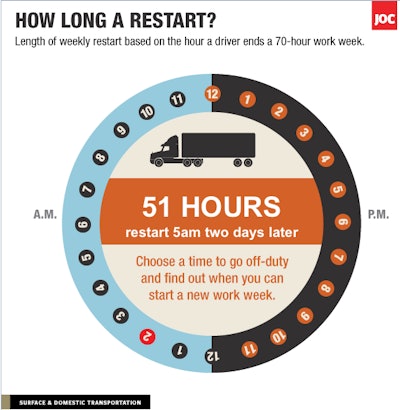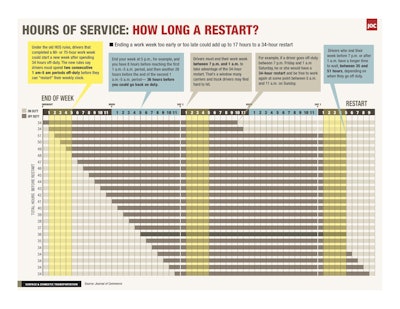 Click here to see the Journal of Commerce’s interactive restart clock.
Click here to see the Journal of Commerce’s interactive restart clock.An interactive infographic posted this week on the Journal of Commerce shows how complying with the hours-of-service rule changes that went into effect July 1 can impact a trucker’s work week and how many actual hours a “34-hour” restart can take out of a driver’s schedule.
Among other changes — like a mandatory 30-minute break after eight on-duty hours — drivers must now include two 1 a.m. to 5 a.m. periods in their 34-hour restart before they can begin a new 70-hour week. Prior to July 1, drivers could take the 34-hour restart whenever they wanted and multiple times a week. Now drivers are limited to one 34-hour restart a week.
As noted in the JOC article, for drivers to attain a restart that satisfies the minimum 34 hours and only that, a driver would have to end his workweek within a 6-hour window between 7 p.m. and 1 a.m. Aiding in the math is a chart that allows drivers to select what time they would go off duty at the end of their week. The chart then shows when a driver would be allowed to resume work and begin his or her next 70-hour week.
For instance, if a driver ended his or her workweek at 3 p.m., he or she would not be able to resume work until 5 a.m. two days later, resulting in a 38-hour restart.

If a driver ended his work week at 2 a.m., however, he also wouldn’t be able to resume work until 5 a.m., resulting in a 51-hour restart period.
Click here to put your schedule into the graph or play with other scenarios.
Displayed below is a PDF from the Journal of Commerce showing how ending a workweek too early or too late could cost a driver an additional 17 hours during a restart. It also shows the other scenarios for a restart, and how much time it will cost drivers to end their workweek at a certain time.
 Click the photo or click here to see the full-sized chart.
Click the photo or click here to see the full-sized chart.










